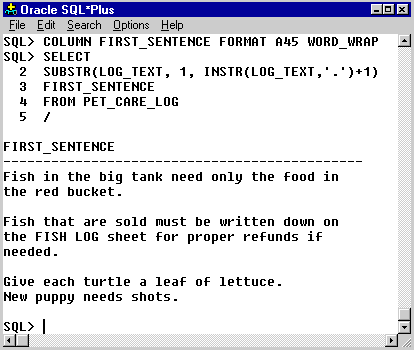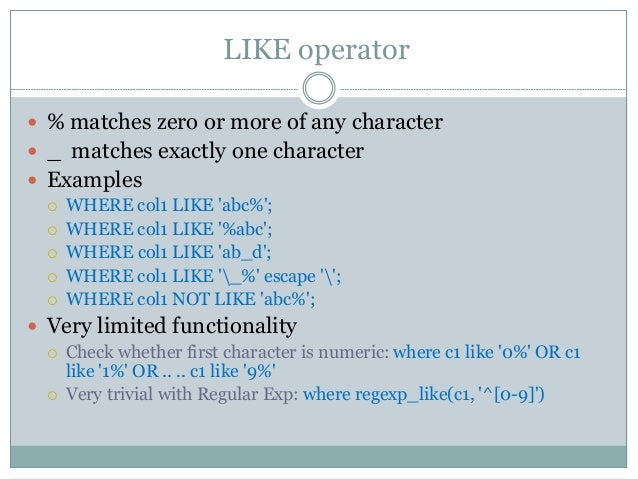Because the length is greater than it returns the whole substring. The functions vary in how they calculate the length of the substring to return. SUBSTR calculates lengths using characters as defined by the input character set. If position is then it is treated as 1. The SUBSTR functions return a portion of char, beginning at character position, substring_length characters long.
Using a combination of SUBSTR , INSTR, and NVL (for strings without an underscore) will return what you want:. How to get string after character oracle - Stack. If the start_position is the begin of the substring will be at the first character of the str.
The following example examines the string, looking for the first substring bounded by commas. Instead of returning the position of the substring, it returns a portion of the source string that matches the regular expression. In SQL Server, you can use SUBSTRING function, but it does not allow you to specify a negative start position, and the substring length must be specified. Purpose: The substring and instring functions are combined on this page because they are, quite often, used together. Dinner starts in one hour.

Can you show an example of using regexp_ substr ? Question: What does the regexp_ substr operator do? Answer: The regexp_ substr operator searches for a sub-string within a string. The REGEXP_ SUBSTR function is the advanced version of the classic SUBSTR function, allowing us to search for strings based on a regular expression pattern. How to split comma separated string and pass to IN clause of select statement. I never really explored the uses of negated character classes before.
For more examples please have a look into the following site. Oracle 10g Changes to Oracle INSTR. The article explains the usage of INSTR and SUBSTR functions. INSTR function INSTR function returns positional occurrence of a character or group of characters (substring) within an input string. By default, it returns the.

For example, the below query will extract. Problem Today, one of the developers come to me and asked me the question that is there any T-SQL function that he could use to remove everything before and after a specific character in string. But, the string values are all different lengths.
Following are important rules to follow along with syntax exemplifying the implications of the rules. The first character of string is at position 1. It’s similar to the REGEXP_INSTR function, but instead of returning the position of the string, it returns the substring. It extends the SUBSTR function but allows the user of regular expressions.
They are easy to understand but sometimes we get bit of confused while actually implementing them. ASCII The ASCII function returns the decimal representation in the database character set of the first character of char. SQL REGEXP_ SUBSTR () function return substring from the original string.
This substring is searching in original string using regular expression pattern. If you omit this parameter or pass an empty string, the default matching modes are used. Before explaining about regexp_ substr i guess readers know about substr function.
This function will help you out in searching a string. You can do this by combing the SUBSTR and INSTR functions. INSTR will return the position of a given character in a string, and SUBSTR will return a specified number of characters from a string.
Use INSTR to get the position of the first comma character , and SUBSTR to return all of the characters up to that position. SUBSTR: Select the first characters of clob_col, and the first bytes of blob_col, for each row. Thus, it seemed like a good time for another SQL Server vs. The new function is named REGEXP_ SUBSTR. Character string functions.

Returns a substring of string s that begins at position p and is l characters long. You can use the new function to perform advanced searches against a string. Position is the beginning of the string.
Hiç yorum yok:
Yorum Gönder
Not: Yalnızca bu blogun üyesi yorum gönderebilir.